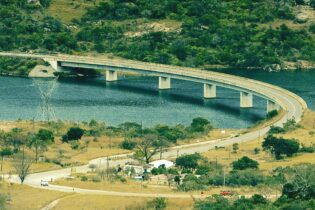Click here to read the full story, with photographs, on the TMSA website.
Kariba is a small town in Mashonaland West province in Zimbabwe, located on the north-western shores of Lake Kariba. Initially established to house workers who were constructing the dam in the mid to late 1950s, the area’s natural attractions soon gave rise to a largely water-based tourism industry. According to a 2011 Zimbabwean parliamentary report*, economic and tourist activity in the area have sharply declined in the last decade. During these lean years, the Kariba Dam wall connecting Zambia and Zimbabwe supported trade between the two countries. “When engineers build a dam they consider it for many uses – one use of the Kariba Dam wall is vehicular traffic,” says Munyaradzi Munodwafa, chief executive of the Zambezi River Authority. Although the bridge is able to bear the reasonable passage of heavy vehicles, as per the limits and volumes specified by the ZRA’s well-documented policy, vehicles over three tonnes were stopped from crossing the bridge in 2005. There was no technical reason for this tonnage restriction, but it was never-the-less enforced, confirms Munodwafa. This restriction affected commercial trucks, cross-border buses ferrying traders moving merchandise between Zambia and Zimbabwe, and the movement of exports and imports by local companies into the region. The trade information desk officer based at the Kariba border post, Shungu Matesanwa, noticed that there was something amiss about the scope of the restriction. “It didn’t seem to be evenly enforced and some large overland trucks were still allowed to cross. I then discovered that there was no policy which said that larger trucks could not cross,” he explains. In 2009 during a stakeholders workshop, Matesanwa was introduced to the Tripartite reporting and monitoring system for non-tariff barriers (NTBs). Investigations into the tonnage restriction showed that there was no technical basis for the restriction, making it a classic example of a NTB. The complaint was logged and directed to the relevant national monitoring committee member in the ministry of transport. They were able to sort out the tonnage restriction and the bridge re-opened for business in July 2011. “Since being resolved, there is a significant change here in Kariba,” confirms Matesanwa, who has witnessed the increase in trade. “Cross-border buses are now allowed to use the bridge, traders can come and go on the same day or on consecutive days and it benefits a lot of businesses in Kariba town too.” “We bring 480 tonnes of mackerel via the Kariba bridge each year, as well as 120 tonnes of salt,” says Livingstone Chado, who manages the procurement operations of a large crocodile farm in Kariba. “The difference is huge now that we can use the Kariba bridge again. If you look at the total travelling time, 14 days to get our goods here has been reduced to seven. This affects our bottom line as trucking costs are really reduced,” says Chado.Kariba Bakeries, which produces about 5 500 loaves of bread a day and move 10 tonnes of pre-mix a week to cities around Zimbabwe, has also benefitted from the resolution of the NTB. The biggest impact in terms of their business has been on transport costs, allowing them to stay competitive, confirms Shadrach Mukwaera, the business’s managing director. “I would say in fact that transport costs have decreased 50% as a result of the lifting of the tonnage restriction,” he confirms. This is because, by using the bridge instead of Chirundu, they cut a lot of mileage every week. “Saving 100km on the journey means saving 100km worth of fuel. Two day trips are now completed in a day.”
While the crocodile farms, bakeries and fisheries in Kariba are benefitting from being able to use the bridge for their exports and imports, small traders are also better off. Chirara Fani is a Zupco bus driver who has been collecting passengers from as far as Masvingo, Chiredzi, the Honde Valley, Hauna business centre and Nyanga in the east of Zimbabwe and driving them to the Kamwala market in Lusaka for more than a decade. When the tonnage restrictions forced the buses to use alternative routes, it reduced the number of buses and significantly increased the travelling time to and from Lusaka. “The passengers were complaining,” says Fani. The imposition of the tonnage restrictions affected small traders and their families in many ways. “Many of our customers are single parents so their earnings through selling and buying are really important,” says Fani. Increasing the time of the journey meant traders would have to spend money on food and accommodation and, leave their children and families for longer periods. Since the tonnage restriction was lifted in 2011, the driver has seen a lot more Zimbabweans trading; an average of two buses a day, carrying about 3500 passengers each month. “These days, hard-working women are our main customers — maybe 90%,” the driver explains. Veronica Chirume is one such trader. She brought in bags of soya, which she sells at the market in Lusaka, and is returning with a suitcase full of nappies, shoes, blouses and handbags, which she will sell in Harare at the Chikurubi Trading Depot. She’s been in business for three years and makes the trip to Lusaka and back once a month. “I do it for my children,” she says, citing her seven-year-old son and her 10-year-old daughter as her primary motivation. “That is why it is good to use this route over the bridge. I am happy with it,” she confirms. Border post statistics confirm that there is more growth on the small traders side than the commercial side, says Muwemba Kawala examining officer and acting station manager of Zambia Revenue Authority (ZRA). The increase in cross-border trade on the non-commercial side (anything below $1000) has also increased Zambia’s revenues from small scale traders. “In 2009, the revenue from informal trade was 28-million kwacha. In 2012, the revenue increased to about 154-million kwacha,” says Kawala. “Revenue from these traders bringing bananas, damp-proof-course rolls (about 200 rolls every second day), other building materials and detergents into Zambia is now 20 to 25% of the total amount we collect; this is just from the traders who come by bus,” says Kawala.






